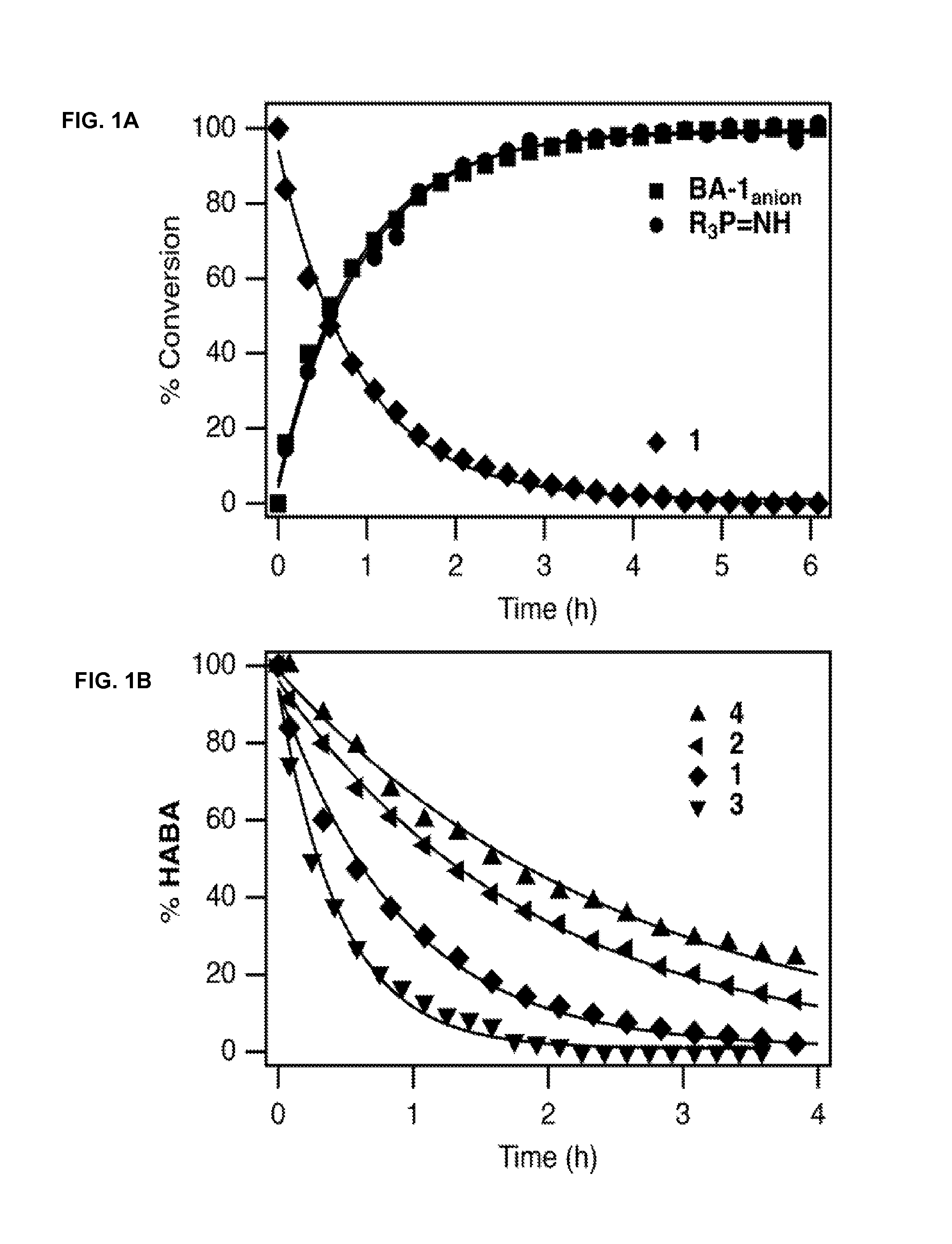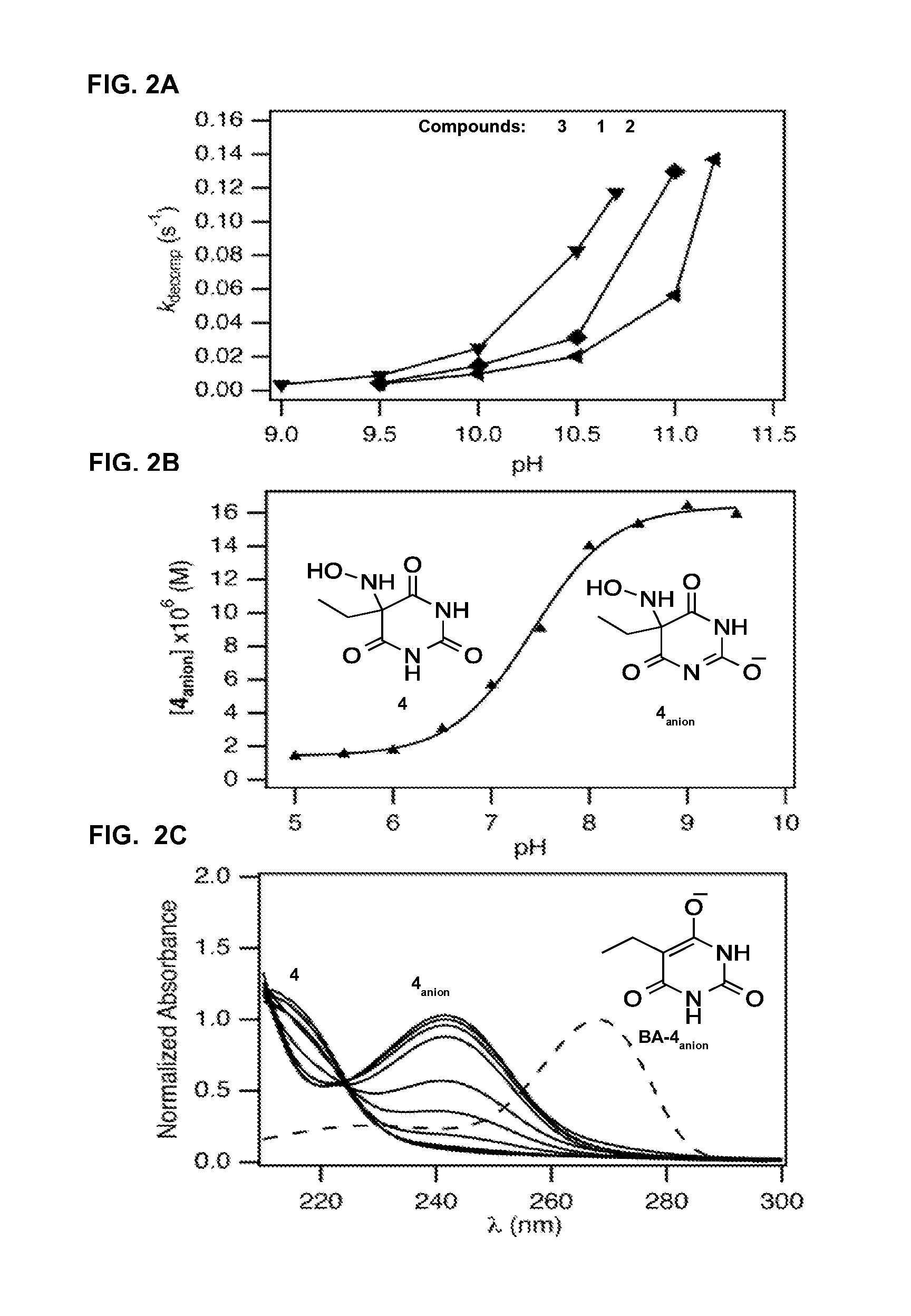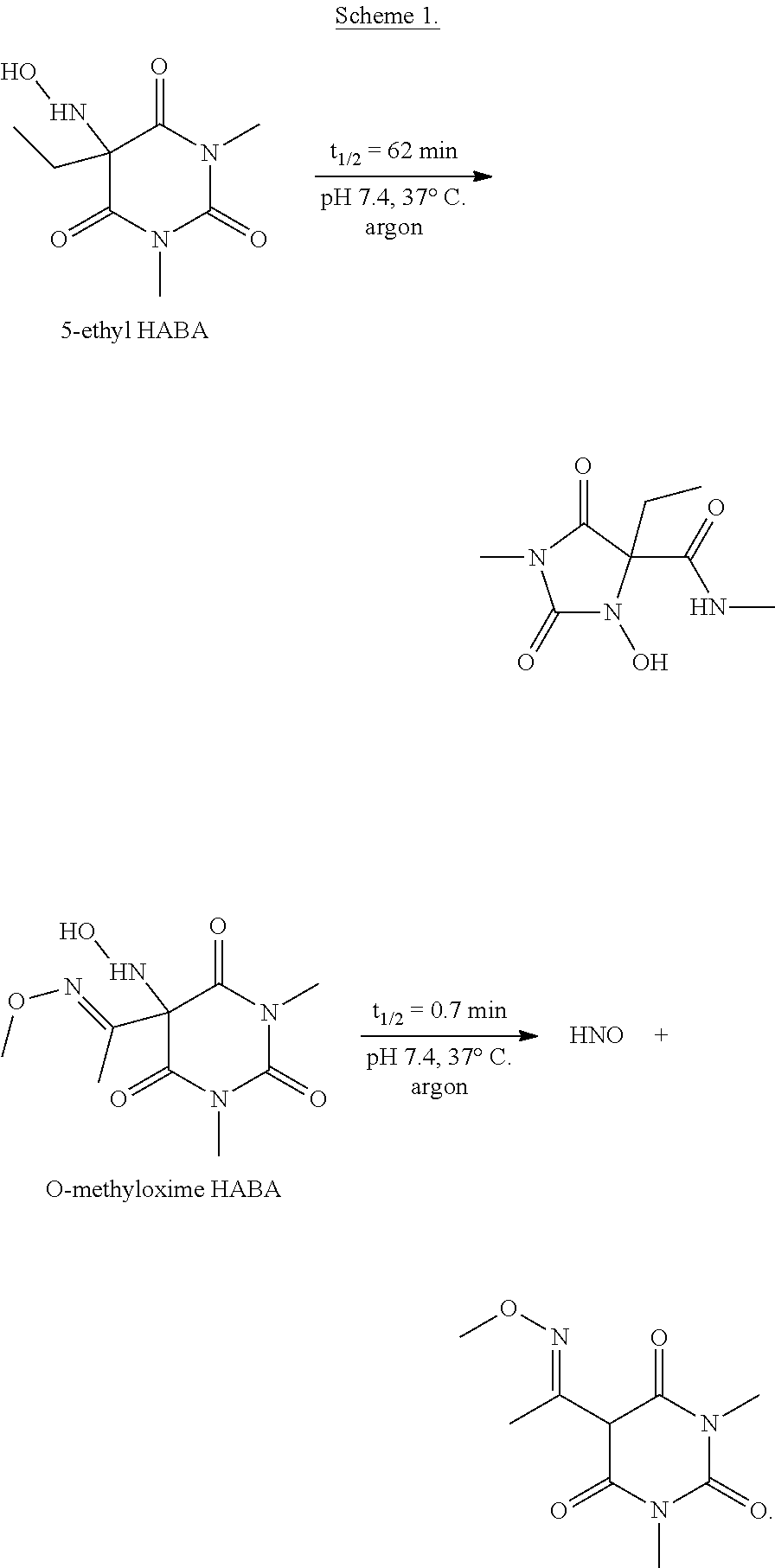N-hydroxylamino-barbituric acid derivatives
a technology of barbituric acid and hydroxylaminobarbituric acid, which is applied in the field of n-hydroxylaminobarbituric acid derivatives, can solve the problems of not understanding these factors, preventing the development of nitroxyl donors for clinical use, and reporting less than the desired amount of hno
- Summary
- Abstract
- Description
- Claims
- Application Information
AI Technical Summary
Benefits of technology
Problems solved by technology
Method used
Image
Examples
example 1
Preparation of 5-(N-hydroxylamino)-5-benzyl-N,N-dimethylbarbituric acid (1)
[0849]
[0850]To 5-benzyl-N,N-dimethylbarbituric acid (BA1) (1.231 g, 5 mmol), Angeli's salt (1.22 g, 10 mmol), and powdered DTPA (0.983 g, 2.5 mmol) under nitrogen at room temperature was cannulated a degassed mixture of 50% aqueous ethanol (25 mL). The reaction was allowed to vigorously stir for 10 minutes in order to dissolve all solids followed by normal stirring under a gentle stream of nitrogen for an additional 1.5 hours. At which time, precipitation of a white solid was observed. The reaction was then diluted with ethanol (200 mL) and concentrated to dryness in vacuo with minimum heat (1H NMR (400 MHz, CDCl3) δ: 7.26 (m, 3H), 6.96 (m, 2H), 6.28 (d, 1H, J=3.2 Hz), 4.98 (d, 1H, J=3.4 Hz, 1H), 3.13 (s, 6H), 3.08 (s, 2H). 13C NMR (100 MHz, CDCl3) δ: 170.01, 150.02, 131.75, 129.19, 128.95, 128.71, 73.64, 42.89, 28.78. HR-MS (FAB). found m / z=278.11411 (MH+); calc. for C13H16N3O4: 278.11408.
example 2
Preparation of 5-(N-hydroxylamino)-5-(4-methoxybenzyl)-N,N-dimethylbarbituric acid (2)
[0851]
[0852]To 5-(4-methoxybenzyl)-N,N-dimethylbarbituric acid (BA2) (55 mg, 0.2 mmol), Angeli's salt (49 mg, 0.4 mmol), and powdered DTPA (39 mg, 0.1 mmol) under argon at room temperature was added a degassed mixture of 50% aqueous ethanol (1 mL). The reaction was allowed to stir for 1.5 hours, diluted with ethanol (>5 mL), and concentrated to dryness in vacuo with minimum heat (1H NMR (400 MHz, CDCl3) δ: 6.88 (d, 2H, J=8.6 Hz), 6.76 (d, 2H, J=8.7 Hz), 6.25 (br. s, 1H), 5.09 (br. s, 1H), 3.76 (s, 3H), 3.15 (s, 6H), 3.03 (s, 2H). 13C NMR (100 MHz, CDCl3) δ: 159.73, 150.11, 130.32, 123.47, 114.27, 73.70, 55.43, 42.08, 28.82. HR-MS (FAB). found m / z=308.12476 (MH+); calc. for C14H18N3O5: 308.12465.
example 3
Preparation of 5-(N-hydroxylamino)-5-(4-chlorobenzyl)-N,N-dimethylbarbituric acid (3)
[0853]
[0854]To 5-(4-chlorobenzyl)-N,N-dimethylbarbituric acid (BA3) (56 mg, 0.2 mmol), Angeli's salt (49 mg, 0.4 mmol), and powdered DTPA (39 mg, 0.1 mmol) under argon at room temperature was added a degassed mixture of 50% aqueous ethanol (1 mL). The reaction was allowed to stir for 1.5 hours, diluted with ethanol (>5 mL), and concentrated to dryness in vacuo with minimum heat (1H NMR (400 MHz, CDCl3) δ: 7.24 (d, 2H, J=8.5 Hz), 6.91 (d, 2H, J=8.5 Hz), 6.23 (d, 1H, J=3.3 Hz), 4.98 (d, 1H, J=3.3 Hz), 3.17 (s, 6H), 3.06 (s, 2H). 13C NMR (100 MHz, CDCl3) δ: 169.96, 149.93, 134.71, 130.60, 130.31, 129.19, 73.14, 41.74, 28.88. HR-MS (FAB). found m / z=312.07483 (MH+, 35Cl), 314.07293 (MH+, 37Cl); calc. for C13H15ClN3O4: 312.07511 (MH+, 35Cl), 314.07246 (MH+, 37Cl).
PUM
 Login to View More
Login to View More Abstract
Description
Claims
Application Information
 Login to View More
Login to View More - R&D
- Intellectual Property
- Life Sciences
- Materials
- Tech Scout
- Unparalleled Data Quality
- Higher Quality Content
- 60% Fewer Hallucinations
Browse by: Latest US Patents, China's latest patents, Technical Efficacy Thesaurus, Application Domain, Technology Topic, Popular Technical Reports.
© 2025 PatSnap. All rights reserved.Legal|Privacy policy|Modern Slavery Act Transparency Statement|Sitemap|About US| Contact US: help@patsnap.com



